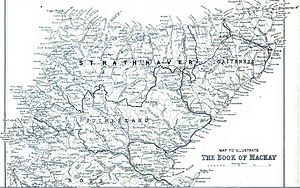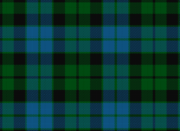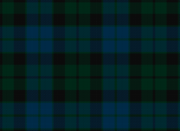Clan Mackay facts for kids
Quick facts for kids Clan Mackay |
|||
|---|---|---|---|
| Mac Aoidh/Clann Mhic Aoidh or Sìol Mhorgain | |||
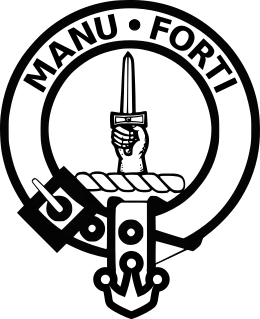
Crest: A dagger held erect
|
|||
| Motto | Manu forti (With a strong hand) | ||
| War cry | Bratach Bhan Chlann Aoidh! | ||
| Profile | |||
| Region | Highland | ||
| District | Strathnaver | ||
| Plant badge | Bulrush | ||
| Pipe music | Bratach Bhan Chlann Aoidh (The White Banner of MacKay) | ||
| Chief | |||
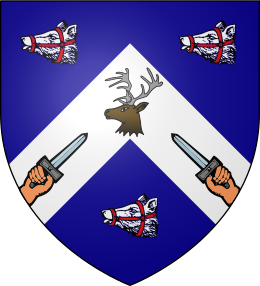 |
|||
| Æneas Simon Mackay | |||
| 15th Lord Reay (Morair Maghrath) | |||
| Historic seat | Castle Varrich | ||
|
|||
|
|||
|
|||
|
|||
Clan Mackay is an old and strong Highland Scottish clan. They came from the far North of Scotland, but their roots are in the old Kingdom of Moray.
In the 14th century, they supported Robert the Bruce during the Wars of Scottish Independence. Later, they were against the Jacobites. The main land of Clan Mackay was called Strathnaver, in the north-west of Sutherland. In the 17th century, their land also included the parish of Reay in Caithness. The chief of the clan is known as Lord Reay.
Contents
History of Clan Mackay
Early Origins of the Clan
The Clan Mackay started a long time ago, around the 1200s. Their first known chief was Iye Mackay, born about 1210. It is believed that the Mackays are connected to the early rulers of Moray.
Around the 1160s, some of their ancestors, the MacHeths, moved north into Strathnaver. There, they were welcomed by Harald Maddadsson, who ruled Caithness.
Fighting for Scottish Freedom
The Mackays were among the clans who helped Robert the Bruce at the famous Battle of Bannockburn in 1314. This battle was a big step for Scotland's freedom.
Later, in 1370, the chief, Iye Mackay, and his son were killed at Dingwall Castle. This led to a lot of fighting with Clan Sutherland. In 1372, the Mackays attacked Dornoch, burning the cathedral and hanging many Sutherland men. The fighting stopped when both clans had to go fight against the English.
Clan Conflicts in the 1400s
In 1403, the Battle of Tuiteam Tarbhach happened between Clan Mackay and Clan MacLeod of Lewis. The MacLeod chief was killed in this fight.
In 1411, Donald of Islay, Lord of the Isles fought for control of the Earldom of Ross. Chief Angus Du Mackay joined the Scottish King's side. At the Battle of Dingwall, Donald of the Isles defeated Mackay and captured him. However, they later made peace, and Donald gave his sister, Elizabeth, to Angus in marriage. This showed how important Clan Mackay had become.
In 1426, the Mackays attacked Caithness. The people of Caithness fought back at the Battle of Harpsdale. Both sides lost many men. King James I of Scotland then met with Angus Du Mackay. Angus gave his son, Neil, as a promise of peace. Neil was held captive at Bass Rock.
In 1431, the Battle of Drumnacoub took place. Chief Angus Du Mackay defeated Clan Sutherland. After being released from Bass Rock, Neil Mackay also won a fight against men from Caithness in 1437. In 1464, the Mackays and Clan Keith defeated Clan Gunn at the Battle of Tannach.
Towards the end of the 1400s, the Mackays and Clan Ross had a long feud. In 1486, the Rosses defeated the Mackays at the Battle of Tarbat, where chief Angus Roy Mackay was killed. But then, the Mackays defeated the Rosses at the Battle of Aldy Charrish, and the Ross chief was killed.
Clan Conflicts in the 1500s
In 1513, chief Iye Roy Mackay and his brother, John Riavach Mackay, led the Mackays at the Battle of Flodden. John Riavach and many clansmen were killed in this battle against the English.
There were more battles with other clans. In 1517, the Battle of Torran Dubh was fought. In 1528, the Mackays were in a feud with the Gordon Earls of Sutherland. In 1542, the Battle of Alltan-Beath took place, where the Clan Sutherland defeated the Mackays.
Chief Iye Du Mackay and his followers fought for Scotland against the English at the Battle of Solway Moss in 1542. He also joined battles at Glasgow in 1544 and the Siege of Haddington in 1548.
In 1555, Borve Castle was captured by the Sutherlands. Chief Iye Du Mackay was taken prisoner. In 1562, the Mackays supported Mary, Queen of Scots at the Battle of Corrichie.
In 1586, William Mackay helped Clan Gunn win against Clan Sinclair at the Battle of Allt Camhna. Later, the Mackays also helped the Earl of Sutherland defeat Clan Gunn at the Battle of Leckmelm.
The 1600s and European Wars
Fighting in Europe
In 1616, chief Donald Mackay was knighted by the king in London. In 1626, Sir Donald Mackay took 3000 men to fight in the Thirty Years' War in Europe. They fought for the King of Denmark.
Sir Donald Mackay was made a Baronet in 1627 and then Lord Reay in 1628. He continued to fight in Germany, helping to capture cities like Stettin. He even tried to raise more men for the King of Sweden.
The English Civil War
In 1638, Lord Reay signed the Covenant, which was a promise to support certain religious ideas. But he was still loyal to King Charles I of England.
When the English Civil War began in 1644, Lord Reay supported King Charles I. He helped defend Newcastle against the Scottish army. When the city was captured, Lord Reay was taken prisoner to Edinburgh Castle.
In 1645, he was freed and went home. King Charles I was executed in 1649. Lord Reay, who had fought for the King, went to Denmark and died there in 1649.
In 1651, some Mackays fought at the Battle of Worcester in England, supporting Charles II of England.
In 1689, General Hugh Mackay led 100 Mackays to keep an eye on the Mackenzies at Brahan Castle. General Hugh Mackay was the Commander-in-Chief in Scotland. He was defeated at the Battle of Killiecrankie but won the overall campaign. Sadly, he was badly wounded at the Battle of Steinkirk in 1692 and died.
The 1700s and Jacobite Risings
Against the Jacobites in 1715
During the Jacobite rising of 1715, Clan Mackay did not support the Jacobites. They sided with King George I of Great Britain. They defended Inverness Castle against the Jacobites. The Mackays also fought at the Skirmish of Alness in 1715. In 1719, 80 Mackays fought at the Battle of Glen Shiel, helping to defeat the Jacobites.
Against the Jacobites in 1745
In the Jacobite rising of 1745, the Mackays again supported the British Government. Mackay soldiers captured gold that had been sent from France to the Jacobite leader Charles Edward Stuart. This event is known as the Skirmish of Tongue.
Mackay soldiers also fought at the Battle of Littleferry in 1746. They defeated the Jacobites and captured the Jacobite leader, George Mackenzie, 3rd Earl of Cromartie, at Dunrobin Castle.
Later History of the Clan
In 1806, the "Mackay's Society" was started in Glasgow. In 1815, at the Battle of Waterloo, a Mackay piper named Kenneth Mackay showed great bravery. He marched out of his regiment's square, playing his bagpipes, while under attack by French cavalry. For his courage, he was given a set of Silver Pipes by the King.
Between 1815 and 1818, the Highland Clearances began to affect the Mackay lands. Many people were forced to leave their homes to make way for sheep farming. In 1829, the Reay estate, which was the Mackay chief's land, was sold.
In 1865, David Mackay won the Victoria Cross for his bravery in India. He captured the flags of an enemy regiment during a battle.
In 1875, the title of Lord Reay passed to a branch of the family living in Holland. Æneas Mackay became the 10th Lord Reay. His son, Donald James Mackay, became the 11th Lord Reay. He moved from Holland and became a Baron in the United Kingdom, with a seat in the House of Lords. He also served as Governor of Bombay in India. In 1900, in South Africa, John Frederick MacKay also won the Victoria Cross for his bravery in battle.
Mackay Castles and Homes
- Castle Varrich in Tongue, Sutherland was a very old home of the Mackay chiefs. They later moved to the House of Tongue. Castle Varrich was once owned by the Bishops of Caithness.
- House of Tongue in Tongue, Sutherland became the main home of the Mackay chief, Lord Reay. It is now owned by the Dukes of Sutherland.
- Borve Castle in Farr, Sutherland was used by the Mackays as a lookout point. It was also called Farr Castle.
- Balnakeil House, near Durness, was owned by the Mackays from 1611. It was a grand house, second only to Tongue House.
- Bighouse near Thurso was home to the Mackay of Bighouse family. Today, it is a hotel and restaurant.
- Dirlot Castle near Watten, Caithness was held by the Mackays from 1499.
- Dounreay Castle near Thurso, Caithness, was once owned by the Clan Sinclair but later by the Mackay Lords Reay. It is now near the Dounreay Nuclear Plant.
- Loch Stack Castle near Scourie, Sutherland, was held by the Mackays of Reay.
- Melness House near Tongue was a Mackay home from the 14th century. An older house there was the site of the Skirmish of Tongue.
- Scourie Castle in Scourie, Sutherland. This was the home of the Mackay of Scoury family.
Clan Chiefs
The current chief of Clan Mackay is Æneas Simon Mackay, 15th Lord Reay. He is also a Baron in the Netherlands.
Clan Tartans
| Tartan image | Notes |
|---|---|
| Clan Mackay ('Logan'), from around 1816. | |
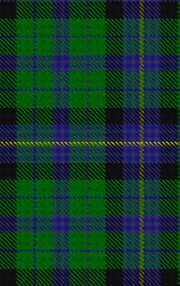 |
Barr-Colony Mackie tartan (Canada) |
 |
Clanmorgan (MacKay) tartan, published in 1842. |
See Also



